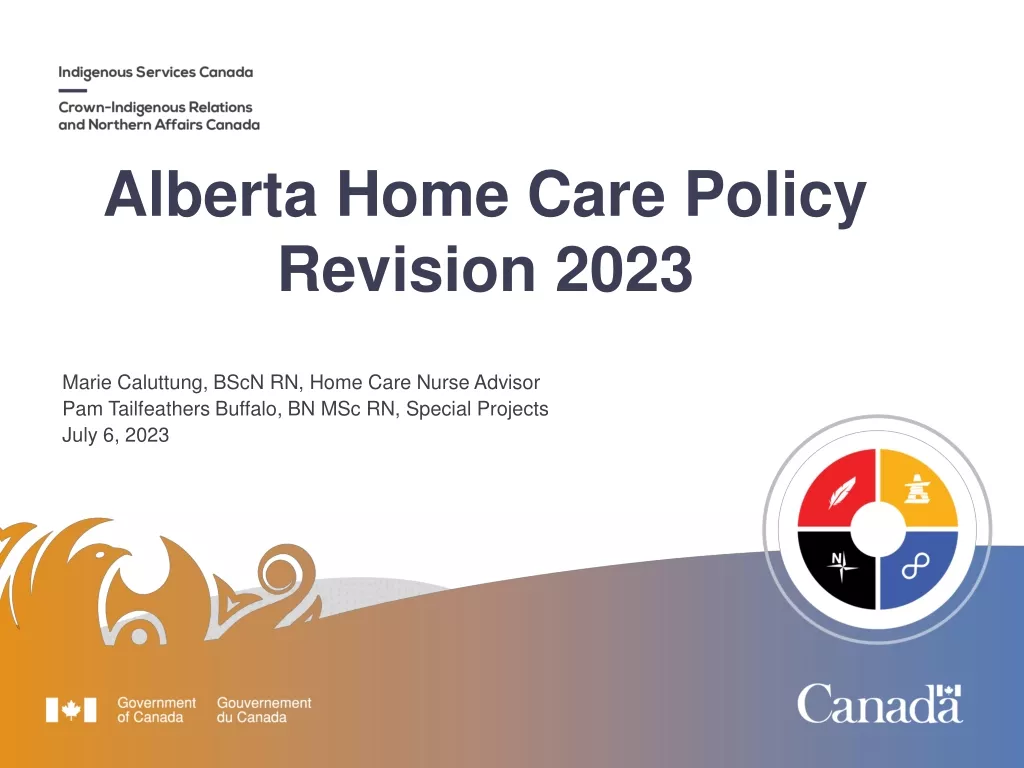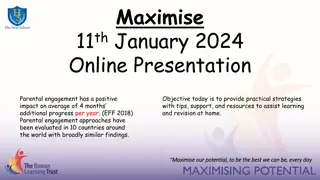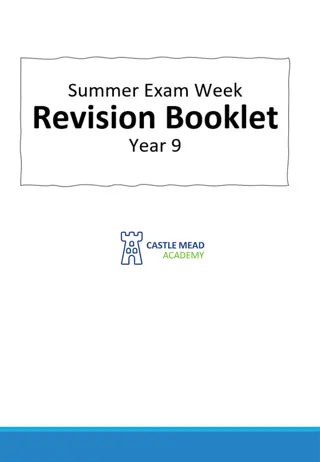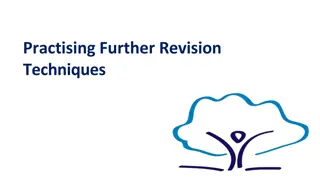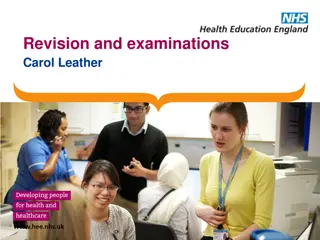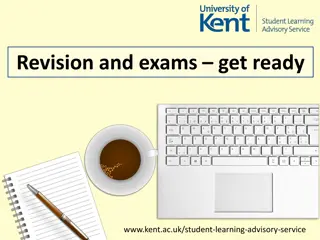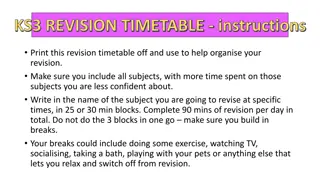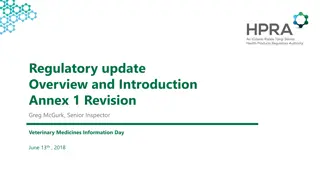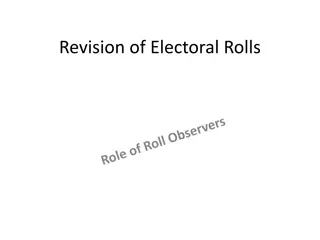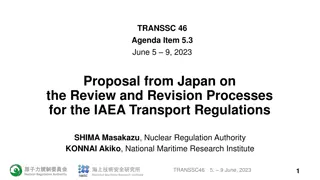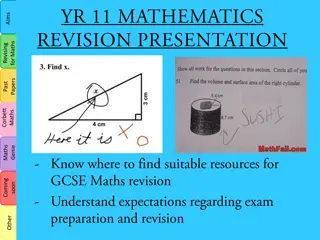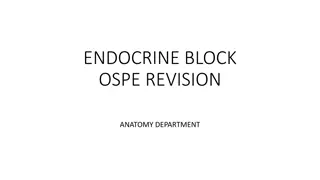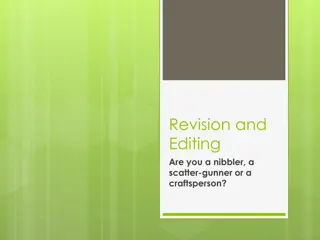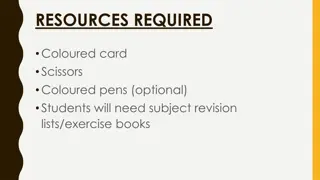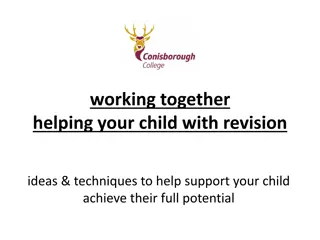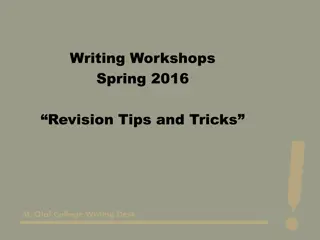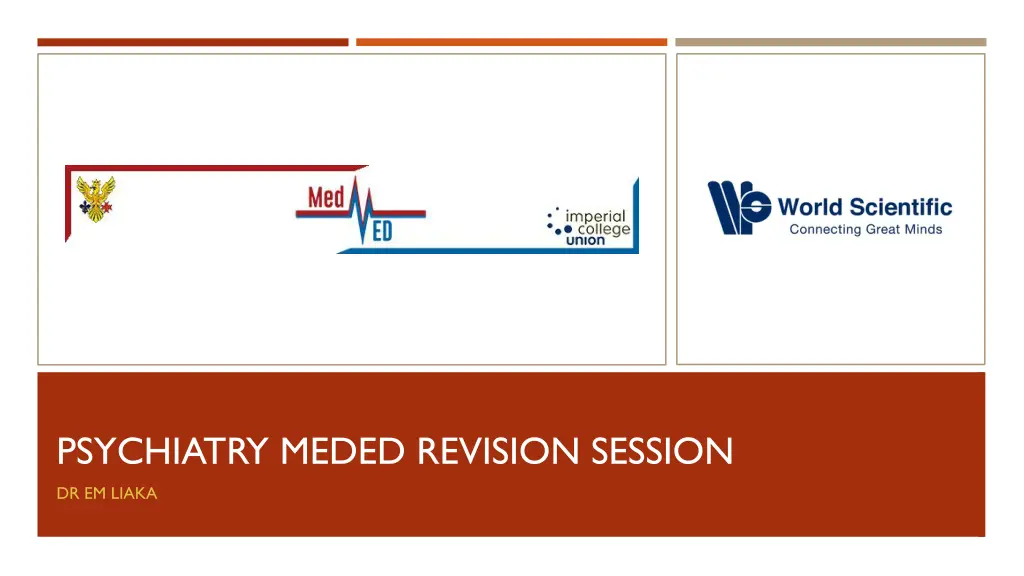
Psychiatry MedEd Revision Session with Dr. Em Liaka
Explore a comprehensive psychiatry MedEd revision session covering topics such as delirium, dementia, geriatric depression, CAMHS, substance abuse, and psychosexual issues. Test your knowledge with clinical scenarios and learn about the differences between delirium, dementia, and depression. Discover the causes of delirium and understand the importance of screening tools like MMSE, ACE-II, AMTS, and GDS in elderly patients.
Download Presentation

Please find below an Image/Link to download the presentation.
The content on the website is provided AS IS for your information and personal use only. It may not be sold, licensed, or shared on other websites without obtaining consent from the author. If you encounter any issues during the download, it is possible that the publisher has removed the file from their server.
You are allowed to download the files provided on this website for personal or commercial use, subject to the condition that they are used lawfully. All files are the property of their respective owners.
The content on the website is provided AS IS for your information and personal use only. It may not be sold, licensed, or shared on other websites without obtaining consent from the author.
E N D
Presentation Transcript
PSYCHIATRY MEDED REVISION SESSION DR EM LIAKA
TOPICS COVERED Old age- delirium, dementia, geriatric depression CAMHS-ASD, mood disorders, conduct disorder Substance abuse- alcohol, opiates, benzodiazepines Psychosexual- libido, gender identity
SBA 1 (A) A 93 year-old woman is admitted to hospital after a NOF fracture and hip replacement. After three days, she becomes confused and paranoid with incoherent speech, with agitation and confusion which is worse at nighttime. Her symptoms fluctuate throughout the day. What is the most likely diagnosis? Delirium 1. Dementia 2. Mania 3. Psychosis 4.
SBA 1 (A) A 93 year-old woman is admitted to hospital after a NOF fracture and hip replacement. After three days, she becomes confused and paranoid with incoherent speech, with agitation and confusion which is worse at nighttime. Her symptoms fluctuate throughout the day. What is the most likely diagnosis? Delirium 1. Dementia 2. Mania 3. Psychosis 4.
DELIRIUM VS DEMENTIA VS DEPRESSION
S Substrates: hyperglycaemia, hypoglycaemia, thiamine Sepsis M Meningitis and other CNS infections Mental Illness, functional psychoses A Alcohol intoxication or withdrawal CAUSES OF DELIRIUM S Seizures: Seizure activity, post-ictal states Stimulants: anticholinergics, hallucinogens, cocaine H Hyper: hyperthyroidism, hyperthermia, hypercarbia Hypo: hypothyroidism, hypothermia, hypoxia, hypotension E Electrolytes: hypernatraemia, hyponatraemia, hypercalcaemia Encephalopathy: hepatic, uraemic, hypertensive, others Drugs (commonly anticholinergics, CNS depressants, or steroids such as prednisolone) D
SBA 1 (B) What is the most useful initial screening tool? MMSE 1. ACE-II 2. AMTS 3. GDS 4.
SBA 1 (B) What is the most useful initial screening tool? MMSE 1. ACE-II 2. AMTS 3. GDS 4.
AMTS Age Time (to nearest hour) Address for recall at end of test (42 West Street) Year Name of Hospital Recognition of 2 people (e.g. doctor/nurse) Date of Birth Year of First World War Name of present Monarch Count backwards 20-1 (this also tests attention) Less than 8 is abnormal
DELIRIUM MANAGEMENT Treat the cause Manage aggravating factors (e.g. pain, dehydration, constipation) Stop unnecessary medications Environmental Management: Reorientation, good lighting, sensory issues,don t move the patient, regular staff members, regular routine, silence unnecessary noises, allow safe wandering Medication: Small night-time dose of benzodiazepines could promote sleep o If short-term sedation is needed, low-dose typical antipsychotics (e.g. haloperidol) or benzodiazepines can be used Consider Referral (Geriatrics/Psychiatry) Associated with: Increased mortality, longer admissions, higher readmission; may take days to weeks to resolve; some patients do not return to pre-morbid levels
DEMENTIA OVERVIEW Acquired syndrome of decline in memory and at least one other cognitive domain (e.g. Language, visuospatial or executive dysfunction) that is sufficient to interfere with social and occupational function in an alert person. (American Psychiatric Association, 1994) The ICD-10 requires the following for a diagnosis:- 1. Disturbed higher cortical function (memory, thinking, orientation) 2. Consciousness is not clouded (to differentiate from delirium) 3. These may be accompanied by affective, motivational, emotional, perceptual, and motor changes.
DEMENTIA OVERVIEW The total population prevalence of dementia among over 65s is 7.1% (Dementia UK update 2014). This equals 1.3% of the entire UK population. The most common cause of dementia in the UK is Alzheimer's disease (62%) followed by vascular (17%) and Lewy body dementia (4%). They may occur together. The proportions of dementia severity among people with late-onset dementia are as follows: 55.4% have mild dementia 32.1% have moderate dementia 12.5% have severe dementia
DEMENTIA TYPES Dementia subtype Early features Alzheimer s disease Vascular dementia Similar to AD, but memory less affected, and mood fluctuations more prominent Physical frailty Stepwise onset Neuropathology Cortical amyloid plaques and neurofibrillary tangles Cerebrovascular disease Single infarcts in critical regions, or more diffuse multi-infarct disease Proportion 50-75% Impaired memory, apathy and depression Gradual onset 20-30% Frontotemporal dementia Personality changes Mood changes Disinhibition Language difficulties Marked fluctuation in cognitive ability Visual hallucinations Parkinsonism (tremor and rigidity) No single pathology damage limited to frontal and temporal lobes 5-10% Dementia with Lewy Bodies Cortical Lewy bodies (alpha-synuclein) <5%
DEMENTIA MANAGEMENT - GENERAL Environmental adaptations e.g. assistive technology, reduce environmental hazards, orientation, carry personal information, dossette boxes/blister aids Social support and carer support Physical health optimization (sensory impairment, delirium, reduce polypharmacy) Psychological therapies (reminiscence therapy, activities such as art and music, behavioural approaches)
DEMENTIA PHARMACOTHERAPY AChE INHIBITORS: Acetylcholinesterase inhibitors (AChE inhibitors) prevent cholinesterase from breaking down acetylcholine. Acetylcholine thought to be deficient in Alzheimer's (due to loss of cholinergic neurons). Donepezil Galantamine Rivastigmine GI side-effects are common. MEMANTINE: NMDA receptor antagonist that blocks the effects of pathologically elevated levels of glutamate that may lead to neuronal dysfunction.
TREATMENT GUIDELINES (NICE) The (AChE) inhibitors donepezil, galantamine and rivastigmine are recommended for mild to moderate AD Memantine is recommended in AD for people with moderate disease who are intolerant/ contraindication to AChE inhibitors or for severe AD For those already taking an AChE-I consider adding memantine in moderate/severe disease Offer donepezil or rivastigmine for DLB if these not tolerated consider galantamine or memantine Only consider AChE-I or memantine for vascular dementia if comorbid AD, Parkinson s disease, or DLB i Do not offer AChE-I for frontotemporal dementia or cognitive impairment due to multiple sclerosis 1. Do not use antipsyhotics in DLB as they can cause confusion, Parkinsonism and death Where severity is defined as follows:- Mild = MMSE 21-26 Moderate = MMSE 10-20 Severe = MMSE 0-10
SBA 2 A 60 year old man presents with a six month history of poor sleep loss of interest, episodes of anxiety and forgetfulness. He shows psychomotor retardation and tends to answer most questions with I don t know . What is the single most likely diagnosis from the list of options below? A. Bipolar disorder B. Dementia C. Depressive illness D. Normal aging process E. Panic disorder
SBA 2 A 60-year-old man presents with a six-month history of poor sleep loss of interest, episodes of anxiety and forgetfulness. He shows psychomotor retardation and tends to answer most questions with I don t know . What is the single most likely diagnosis from the list of options below? A. Bipolar disorder B. Dementia C. Depressive illness D. Normal aging process E. Panic disorder
DEMENTIA IN THE ELDERLY Cognitive problems result from depression Often reply 'don't know' to questions (compared to people with true dementia who tend to attempt an answer but give incorrect responses) AKA pseudodementia Similar management, SSRIs are first line (e.g. citalopram)- start low go slow. ECT is sometimes used in psychotic or life-threatening depression Consider social issues i.e. care needs.
CAMHS 1 in 8 of those aged 5-19 have a mental disorder. ('The mental health of children and Young people in England SoH Survey 2017 ) Emotional disorders (e.g. anxiety and depression) are most common followed by behavioural (e.g. conduct disorder), then hyperactivity, then other (such as ASD, eating disorder, and tic disorders). There has been a slight increase in the prevalence of mental disorder over recent decades.
SBA 3 Tommy is a 3 year-old boy, who is brought in by his mother. She is concerned as he has recently started preschool and does not behave like his peers. He does not seem to be interested in playing or talking with others, and has limited speech, only talking about his one interest (dinosaurs), and losing complete interest on any other topic. His teachers have also commented that he does not make eye contact or initiate conversation with them or his peers. What is the most likely diagnosis? Depression 1. Anxiety 2. Autism 3. Conduct disorder 4.
SBA 3 Tommy is a 3 year-old boy, who is brought in by his mother. She is concerned as he has recently started preschool and does not behave like his peers. He does not seem to be interested in playing or talking with others, and has limited speech, only talking about his one interest (dinosaurs), and losing complete interest on any other topic. His teachers have also commented that he does not make eye contact or initiate conversation with them or his peers. What is the most likely diagnosis? Depression 1. Anxiety 2. Autism 3. Conduct disorder 4.
ASD Autism spectrum disorder (ASD) is a pervasive and life-long disorder, characterised by profound deficits in communication and social understanding, together with restrictive and repetitive behaviours. The worldwide population prevalence is about 1% Comorbidity is common (>70% have concurrent conditions). The male to female ratio of ASD is estimated to be 4:1. Both genetic and environmental risk factors: Family history. Risk of autism is increased 10 fold if a full sibling has the diagnosis and about 2 fold if a cousin has the diagnosis. Children born to older parents are at a higher risk. Children who are born prematurely or with low birth weight are at greater risk. Valproate exposure during pregnancy
ASD MANAGEMENT Educational and behavioural interventions (ABA, ESDM, Hanen Programme) There are no validated pharmacological treatments that alleviate core ASD symptoms. Second generation antipsychotics (SGAs) are first line for children and adolescents with ASD-associated irritability. Risperidone and aripiprazole have been (relatively) reliably shown to help irritability, disruptive behaviours, aggression and hyperactivity.
SBA 4 Christina is a 13 year-old girl, who is brought in by her worried mother. She reports that Christina has recently been behaving differently: whereas she was previously energetic, sporty and cheerful, she has recently lost all interest in her activities and school work, and is sleepy and lethargic all the time, finding it difficult to get up from bed. She is also less interested in talking with her parents and brother and appears sad most of the time. On further questioning, her mother reveals that she and Christina s father are going through a difficult divorce which is causing a lot of family stress. What is the most likely diagnosis? 1. Depression 2. Anxiety 3. PTSD 4. Conduct disorder
SBA 4 Christina is a 13 year-old girl, who is brought in by her worried mother. She reports that Christina has recently been behaving differently: whereas she was previously energetic, sporty and cheerful, she has recently lost all interest in her activities and school work, and is sleepy and lethargic all the time, finding it difficult to get up from bed. She is also less interested in talking with her parents and brother and appears sad most of the time. On further questioning, her mother reveals that she and Christina s father are going through a difficult divorce which is causing a lot of family stress. What is the most likely diagnosis? 1. Depression 2. Anxiety 3. PTSD 4. Conduct disorder
CAMHS DEPRESSION MANAGEMENT First line treatment for depression (and anxiety) in children and adolescents is psychological based therapy. (CBT, IPT) If required, an SSRI should be started. Fluoxetine is first-line, sertraline and citalopram are second-line. For psychotic depression use a second-generation antipsychotic. ECT should only be considered for young people with very severe depression and life-threatening symptoms .
SBA 5 Robert is a 12 year-old boy who is referred by the GP after his mother brought him in. He has causing problems at school, including bullying others and starting fights (on one occasion with a knife), smoking and truanting, as well as having recently injured the family cat after attempting to cut its ear off. What is the most likely diagnosis? 1. Oppositional defiant disorder 2. Conduct disorder 3. ADHD 4. Autism
SBA 5 Robert is a 12 year-old boy who is referred by the GP after his mother brought him in. He has causing problems at school, including bullying others and starting fights (on one occasion with a knife), smoking and truanting, as well as having recently injured the family cat after attempting to cut its ear off. What is the most likely diagnosis? 1. Oppositional defiant disorder 2. Conduct disorder 3. ADHD 4. Autism
CONDUCT DISORDERS Age 3-11 Intervention Group parent based training programs (or parent AND child training programmes for children with complex needs). If both parents not able to participate then individual training should be offered Conduct disorders are characterised by a repetitive and persistent pattern of antisocial, aggressive, or defiant conduct. Oppositional defiant disorder shares the negative attributes but in a more limited fashion. Diagnosis: Requires three out of fifteen possible symptoms, covering the areas of: aggression to people and animals; destruction of property; deceitfulness or theft; serious violations of rules. 9-14 Child-focused programmes 11-17 Multimodal interventions with a family focus
SBA 6 A 48 year-old businessman comes into your GP practice after his partner expressed concerns about his drinking habits. Which of the following assessment tools would be first-line? 1. CIWA 2. AUDIT 3. BDI 4. HAMD-S
SBA 6 A 48 year-old businessman comes into your GP practice after his partner expressed concerns about his drinking habits. Which of the following assessment tools would be first-line? 1. CIWA 2. AUDIT 3. BDI 4. HAMD-S
SUBSTANCE ABUSE-ALCOHOL Alcohol misuse is a significant problem, especially in the UK which shows among the highest rates of all the European countries. Prevalence in men 6% Prevalence in women 2% Alcohol dependence Both alcohol dependence and binge drinking are more common in men than women. Binge drinking 21% 9% Screening and Assessment Tools: AUDIT alcohol use disorders identification test (>15 requires comprehensive assessment) SADQ severity of dependence CIWA-Ar clinical institute withdrawal assessment of alcohol scale (for severity of withdrawal) APQ alcohol problems questionnaire (assess the nature and extent of the problems arising from alcohol misuse)
ALCOHOL DEPENDENCE DIAGNOSIS- ICD 10 1. Alcohol is often taken in larger amounts or over a longer period than was intended. 2. There is a persistent desire or unsuccessful efforts to cut down or control alcohol use. 3. A great deal of time is spent in activities necessary to obtain alcohol, use alcohol, or recover from its effects. 4. Craving, or a strong desire or urge to use alcohol. 5. Recurrent alcohol use resulting in a failure to fulfill major role obligations at work, school, or home. 6. Continued alcohol use despite having persistent or recurrent social or interpersonal problems caused or exacerbated by the effects of alcohol. 7. Important social, occupational, or recreational activities are given up or reduced because of alcohol use. 8. Recurrent alcohol use in situations in which it is physically hazardous. 9. Alcohol use is continued despite knowledge of having a persistent or recurrent physical or psychological problem that is likely to have been caused or exacerbated by alcohol. 10. Tolerance 11. Withdrawal
MANAGEMENT For harmful drinking and mild alcohol dependence: o Offer psychological intervention (e.g. CBT, behavioural therapy, social network and environment-based) focused on alcohol-related cognitions Weekly 1 hour sessions for 12 weeks o Offer behavioural couples therapy (if a regular partner is present) Refer to groups such as AA/GCL If no response to above or if pharmacological treatment requested, offer the following alongside psychological therapy: Acamprosate (anti-craving) Naltrexone
PHARMACOLOGICAL MANAGEMENT Drug Acamprosate Synthetic taurine analogue that acts as a glutamatergic NMDA antagonist and increases GABA. Decreases cravings. Mechanism Very common side-effects (>1/10) Licensed Diarrhoea NICE recommended Yes Yes Naltrexone Non-selective opioid receptor antagonist. Reduces cravings and reward mechanism. Nervousness, anxiety, insomnia, headache, sleep disorders, restlessness, arthralgia, myalgia, abdominal pain, abdominal cramps Yes Yes Disulfiram Inhibits enzyme aldehyde dehydrogenase resulting in accumulation of acetaldehyde (toxic metabolite of alcohol). Antabuse. Frequency of side-effects not known Yes Yes when acamprosate and naltrexone are not suitable Nalmefene Opioid antagonist Insomnia, dizziness, headache, nausea Yes Yes- rarely used.
MANAGEMENT o Consider inpatient assisted withdrawal if one or more of the following: 30+ units/day 30+ on SADQ History of epilepsy, delirium tremens or withdrawal-related seizures Need concurrent withdrawal of alcohol and benzodiazepines Significant psychiatric comorbidity or significant learning disability Lower threshold for inpatient treatment in vulnerable groups (e.g. homeless, older people) Children (10-17) Should also receive family therapy for about 3 months
ALCOHOL WITHDRAWAL Sx of withdrawal begin from 3-12 hrs after drinking stops. Symptoms peak between 24-48 hours. Can last up to 14 days. Withdrawal seizures (usually generalised) typically occur 12-18 hours after the last drink. A small percentage of people (3-5%) undergoing withdrawal experience delirium tremens (DT). This usually occurs 3-4 days following alcohol cessation. The mortality rate for this condition is 10-20% if untreated*. Alcohol withdrawal symptoms Agitation / anxiety / irritability Tremor of hands, tongue, and eyelids Sweating Nausea / vomiting / diarrhoea Fever Tachycardia Systolic hypertension General malaise
ALCOHOL WITHDRAWAL MANAGEMENT Category Score Fixed-dose or symptom-triggered (CIWA scale) regimen CIWA-Ar mild <10 (no need for additional medication) Preferred medication: chlordiazepoxide or diazepam If liver impairment, consider lorazepam (limited hepatic metabolism) Gradually reduce the dose over 7-10 days CIWA-Ar moderate < 15 (and > 10) This will be longer if concurrent benzodiazepine withdrawal treatment required (up to 3 weeks) CIWA-Ar severe > 15 Thiamine to prevent Wernicke s .This should be parenteral if they are in a hospital setting or if Wernicke s is suspected. Should be given for a minimum of 5 days and then followed by oral Tx, If an antipsychotic is required, haloperidol is the treatment of choice.
DELIRIUM TREMENS Features of delirium tremens MAIN: Clouding of consciousness / confusion Vivid hallucinations, particularly visual and tactile Marked tremor OTHER: Autonomic hyperactivity Tachycardia Hypertension Sweating Fever Paranoid delusions Agitation Insomnia Risk factors: - abnormal liver function - old age - severity of withdrawal symptoms - concurrent medical illness - heavy alcohol use / severe dependence - self-detox (no medical input) - previous hx of DT - low potassium - low magnesium - thiamine deficiency
SBA 7 A 38 year-old homeless man presents to A&E, reporting abdominal pain. On examination, he shows piloerection, frequent yawning, and increased sweating. What s the most likely diagnosis? 1. Alcohol withdrawal 2. Cocaine withdrawal 3. Methamphetamine withdrawal 4. Opiate withdrawal
SBA 7 A 38 year-old homeless man presents to A&E, reporting abdominal pain. On examination, he shows piloerection, frequent yawning, and increased sweating. What s the most likely diagnosis? 1. Alcohol withdrawal 2. Cocaine withdrawal 3. Methamphetamine withdrawal 4. Opiate withdrawal
OPIOIDS Withdrawal symptoms may develop upon abrupt discontinuation of opioids after 5 days of regular and uninterrupted opioid use. For short-acting opioids (eg, heroin), acute withdrawal symptoms usually begin 4-6 hours after the last dose, peak in 32-72 hours, and diminish over the next 3 to 5 days. For longer-acting opioids (eg, methadone) acute symptoms occur within 30 to 72 hours after last dose (although anxiety may occur before this), peak at day 4-6, and resolve over the next 10 days or so. Untreated buprenorphine withdrawal typically lasts for up to 10 days. Symptoms of acute withdrawal Myalgia and arthralgia Hyperalgesia Gastrointestinal distress (eg, stomach cramping, nausea, loose stools) Anxiety Moodiness / dysphoria Irritability Insomnia Hot or cold flashes Poor concentration Increased drug craving Signs of withdrawal Tachycardia Hypertension Diaphoresis Rhinorrhea Oscitation (ie, yawning) Increased lacrimation Muscle twitching Restlessness Vomiting Diarrhea Piloerection (ie, gooseflesh) Tremor Mydriasis
MANAGEMENT General guidelines: harm reduction and stabilization/maintenance (i.e. opioid medication, needle exchange). Abstinence (detoxification) can be attempted in highly motivated patients. Both methadone and buprenorphine are maintenance-oriented treatments use in people who are opioid dependent. Methadone should be prescribed as the first choice for maintenance. Detoxification: o 1stl ine: methadone or buprenorphine o Consider lofexidine (alpha-2 agonist) if mild dependence or keen to detoxify over a short period of time o Decisions about the dosing regimen should be based on severity of dependence, stability of the patient and the setting of detoxification Duration: Inpatient: up to 4 weeks Community: up to 12 weeks o Withdrawal Symptoms: clonidine and lofexidine can hep
BENZODIAZEPINE DEPENDENCE Benzodiazepines are known to be addictive. For this reason, it is recommended that they should be prescribed as a hypnotic or anxiolytic for no longer than 4 weeks. Symptoms of benzodiazepine withdrawal Physical Stiffness Weakness GI disturbance Paraesthesia Flu-like symptoms Visual disturbance Psychological Anxiety Insomnia Nightmares Depersonalisation Decreased memory and concentration Delusions and hallucinations Depression Patients on short acting benzodiazepines who are keen to withdraw from them should first be converted to diazepam. This is because diazepam has a longer half-life and so tends to produce less severe withdrawal. Withdrawal may take several months
PSYCHOSEXUAL Low libido: Establish there are no physical health problems Treatment is mainly psychological: sensate focus therapy; timetabling Sex Hypersexuality: CBT-based treatments Can also use SSRI s, GnRH therapies and anti-androgens Erectile Dysfunction: Modifiable Risk Factors Stop smoking, exercise, reduce weight and alcohol, stress management, diabetes, hypertension , review meidcations Phosphodiesterase-5 inhibitors (Viagra); Intracavernosal prostaglandin self-injections before intercourse; Vacuum pumps
GENDER IDENTITY DISORDERS (ICD-10) The ICD-10 lists the following 'gender identity disorders : Code F64.0 Disorder Transsexualism Transsexualism is a desire to live and be accepted as a member of the opposite sex. F64.1 Dual-role transvestism Dual-role transvestism is the wearing of clothes of the opposite sex in order to enjoy the temporary membership of the opposite sex without the desire for a permanent sex change. F64.2 Gender identity disorder of childhood No sexual excitement accompanies the cross-dressing (this distinguishes it from fetishistic transvestism). F64.8 Other F64.9 Unspecified
GENDER DYSPHORIA (DSM-5) DSM-5 gender dysphoria A. A marked incongruence between one s experienced/expressed gender and their assigned gender, lasting at least 6 months, as manifested by at least two of the following: - A marked incongruence between one s experienced/expressed gender and primary and/or secondary sex characteristics (or in young adolescents, the anticipated secondary sex characteristics) - A strong desire to be rid of one s primary and/or secondary sex characteristics because of a marked incongruence with one s experienced/expressed gender (or in young adolescents, a desire to prevent the development of the anticipated secondary sex characteristics) - A strong desire for the primary and/or secondary sex characteristics of the other gender - A strong desire to be of the other gender (or some alternative gender different from one s assigned gender) - A strong desire to be treated as the other gender (or some alternative gender different from one s assigned gender) - A strong conviction that one has the typical feelings and reactions of the other gender (or some alternative gender different from one s assigned gender) B. the condition is associated with clinically significant distress or impairment in social, occupational, or other important areas of functioning.
FEEDBACK Any questions?


